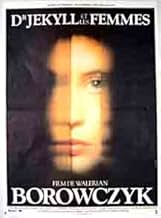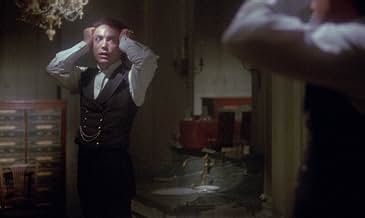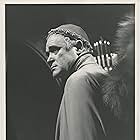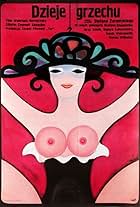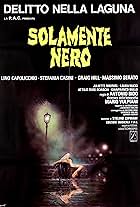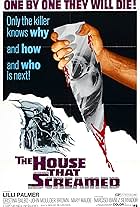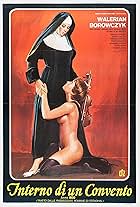The Strange Case of Dr. Jekyll and Miss Osbourne
Original title: Docteur Jekyll et les femmes
IMDb RATING
6.1/10
1.5K
YOUR RATING
In 19th century London, a sex maniac sneaks into the engagement party of Dr. Henry Jekyll and Miss Fanny Osbourne, turning the event into a nightmarish whirlpool of murder and debauchery.In 19th century London, a sex maniac sneaks into the engagement party of Dr. Henry Jekyll and Miss Fanny Osbourne, turning the event into a nightmarish whirlpool of murder and debauchery.In 19th century London, a sex maniac sneaks into the engagement party of Dr. Henry Jekyll and Miss Fanny Osbourne, turning the event into a nightmarish whirlpool of murder and debauchery.
- Awards
- 1 win
Louis Colla
- Mr. Maw
- (as Louis Michel Colla)
Michel Lévy
- Poole the manservant
- (uncredited)
- Director
- Writers
- All cast & crew
- Production, box office & more at IMDbPro
Storyline
Did you know
- Trivia"Fanny Osbourne" was the name of Robert Louis Stevenson's real life fiancée, who was so shocked by his original draft of "The Strange Case of Doctor Jekyll and Mr Hyde" that Stevenson threw the manuscript into the fire and wrote a completely different story.
- Alternate versionsA UK video release entitled Bloodbath of Dr Jekyll cuts from the opening murder of the little girl to the aftermath of Mr Hyde's later attack on the dancer, deleting some 26 minutes of footage inbetween.
- ConnectionsFeatured in Dr. Jekyll and Miss Osbourne: An Interview with Marina Pierro (2015)
Featured review
'Borowczyk brings to this the same bizarre poetic sensibility which made GOTO, ISLAND OF LOVE (1968) and BLANCHE (1971) such outlandish wonders, but which forced him into working in the margins of the sex-film industry. He takes the traditional elements of the Stevenson story and turns them to his own surreal ends: the good doctor is transformed into a raving beast and then stalks the corridors of a rambling Victorian house; the inhabitants find themselves under siege from within, and the threat is largely sexual. As usual Borowczyk exercises his immaculate, painterly eye for unusual objects and settings and a fetishist's delight in costume (especially shoes). God knows what the raincoat trade makes of it: a film of strange and outrageous beauty which seems to emanate from that place where our fears are also desires.' Chris Peachment, Time Out Film Guide, 1998.
This succinct but intuitive review introduced me to Walerian Borowczyk's controversial adaptation of the Robert Louis Stevenson novella but it is only now, some five years later, that I finally managed to watch the film for the first time via a dub taken from the out-of-print Belgian VHS released by the 'Hollywood' label, albeit after having had the ignominy of being detained by the local censors for nearly a month due to its 'obscene' content! Even though the VHS tape is entitled THE BLOODBATH OF DR. JEKYLL, the film's opening credits give the title in French which is then subtitled in English as THE STRANGE CASE OF DR. JEKYLL AND MISS OSBOURNE.
DOCTEUR JEKYLL ET LES FEMMES marked the first time I had witnessed Udo Kier in the lead: at times, his curly-haired Dr. Jekyll was visibly reminiscent of a straight Gene Wilder. I had previously only watched Udo Kier doing his cameos in Dario Argento's SUSPIRIA (1977); Rainer Werner Fassbinder's THE THIRD GENERATION (1979); two for Lars von Trier - the 1994 TV-Series THE KINGDOM and BREAKING THE WAVES (1996); Wim Wenders' THE END OF VIOLENCE (1997); Armageddon (Michael Bay, 1998); END OF DAYS (Peter Hyams, 1999); and as producer/art director/costume designer Albin Grau in SHADOW OF THE VAMPIRE (E. Elias Mehrige, 2000). I'd love to watch him playing Jack The Ripper in Borowczyk's LULU (1980), a remake of one of the finest of all Silent films G.W. Pabst's PANDORA'S BOX (1928).
Furthermore, DOCTEUR JEKYLL ET LES FEMMES was also the third time Borowczyk had utilized the then twenty-one year old Marina Pierro, after 1977's INTERNO DI UN CONVENTO aka BEHIND CONVENT WALLS (which has just been released on R2 DVD in an English-dubbed version in the UK) and 1979's LES HEROINES DU MAL aka THREE IMMORAL WOMEN, and he would go on to use her twice more in ARS AMANDI aka THE ART OF LOVE (1983) and his own last completed film, CEREMONIE D'AMOUR aka LOVE RITES (1988). Even though she was supposed to have partaken of Jekyll's serum, Borowczyk chose not to tamper with the actress' loveliness by transforming Fanny Osbourne into a wretched-looking creature (with king-sized boobs, perhaps?); the effect the potion had on her was more a liberating one, shedding all her sexual inhibitions and, perhaps more tellingly, severing the repressive ties which had bound her all her life to the hypocritical social mores of the ever-so respectable Victorian society by repeatedly stabbing her mother to death with a knife. In the end, after decimating the entire household, all that is left for them to do is to devour each other in one last tender, bloody, animalistic embrace.
Borowczyk also managed to offer meaty roles to two fine actors who weren't always used sensibly by other film-makers Patrick Magee and Howard Vernon. Magee's distinctive voice was definitely one of his major assets and proves to be the saving grace in an otherwise poorly-dubbed picture. Although unusually restrained in the earlier part of the film, he gets more and more unhinged (which is the way we love him) as the film goes on and the hunt for the assassin gets underway, culminating in his ecstatic whipping of his bare-bottomed daughter for nonchalantly indulging in some serious love-making with the well-endowed Edward Hyde, as he lies tied to a chair a few paces away from them! Vernon, playing Dr. Lanyon, even gets to examine the dead bodies of the underaged ballerina and a young male guest, who had unceremoniously been subjected to Hyde's 'organ'. Unfortunately, these two particular scenes are often cut due to the graphic nature (both visual and verbal) of the examination.
Borowczyk directs the film in a strange and elliptical style which is characterized by intermittently interweaving, in the earlier parts of the film, unsettling flashforwards to the murders yet to come, thus further disorienting the viewer and ensnaring him in the sick climate which pervades the whole film. Besides writing and directing (for which he won the Best Direction Award at the Catalonian International Film Festival), Borowczyk himself was also responsible for the film's elegant but sinister décor which, confined as it is almost exclusively to the Jekyll household, imbues the proceedings with a highly appropriate feeling of claustrophobia, which not only implies the imminent danger that the guests constantly face from the predatory beast lurking within the premises, but could also reflect the chains of propriety I mentioned earlier and which had a strong hold over the British people in those Victorian times, a theme which was also explored in the classic Mamoulian/March version. The only scene which is set away from the Jekyll mansion is the film's very opening sequence: Hyde's vicious attack on a little girl in a fog-bound alley in the dead of night is a brutally effective scene which plunges the viewer immediately into the narrative and requires that he/she be already familiar with the plot line. I also liked the blackly humorous touch of having Hyde sign the register of congratulatory notices as if he were a regular guest to the party celebrating the engagement of Dr. Henry Jekyll to Miss Fanny Osbourne.
The transformation sequences were quite different from what we were used to in other film versions by virtue of the fact that this time around Dr. Jekyll dissolves his mixture in a bathtub full of water and jumps right into it (rather than by simply drinking the potion). I have my doubts whether it was actually Udo Kier who was stomping around in the Hyde make-up so complete and 'successful' was the transformation, especially the face which bears an uncanny resemblance to a dark-haired Brian Eno! The mythic 'phallus', which was perhaps the direct side effect of the potion (and I daresay intentionally so), does make its presence felt (ouch!) but not in a vulgar or gratuitous way; in fact, we see it in action only twice - on the General's oversexed daughter and, more disturbingly, on the aforementioned male guest but, for all I know, it wouldn't really have embarrassed much any consummate male porno star!
Apart from the common violent outburts and anarchic characteristics present in earlier film adaptations of the story, Borowczyk's vision of Hyde possesses a few distinctive traits like his penchant for hanging the carcasses of his victims from the ceiling - perhaps as a nod towards Leatherface's antics in Tobe Hooper's THE Texas CHAINSAW MASSACRE (1974), a film which I haven't yet had the opportunity to watch, by the way but also, more amusingly, his fondness for shooting poisoned arrows (an engagement present from the General, no less) at his victims, including the very same General and his daughter! The latter also brings out another of Borowczyk's thematic attributes - which can also be found in the two other films of his which I have watched so far, BLANCHE (1971) and LA BETE (1975) which is the eroticising of inanimate objects: in LA BETE, both Lisbeth Hummel (a rose) and Pascale Rivault (the bed-post) made unique use of such items to satisfy their lustful appetites; in DOCTEUR JEKYLL, the General's daughter lovingly caresses a sewing machine as she is being sodomized by Hyde's 'organ'.
I cannot finish off this review of DOCTEUR JEKYLL ET LES FEMMES without mentioning the immeasurable contribution made by (don't laugh) Bernard Parmegiani, whose highly effective minimalist score recurs unnervingly almost throughout the film's entire duration. The print utilized for the VHS transfer was a bit murky and soft on the whole, but this may have been a conscious decision on Borowczyk's part as to how the film should look or else, it may have been the result of the various screenings that the tape underwent at the hands of those bastards at the local censorship board!
DOCTEUR JEKYLL ET LES FEMMES is the eighth film version I have watched of the famous horror story: the Silent 1920 version starring John Barrymore and directed by John S. Robertson; the magnificent Rouben Mamoulian version which led to Fredric March winning his first Academy Award in 1931; the 1941 Spencer Tracy/Victor Fleming version; the Tom and Jerry Oscar-nominated animated short subject DR. JEKYLL AND MR. MOUSE (Joseph Barbera and William Hanna, 1947); ABBOTT AND COSTELLO MEET DR. JEKYLL AND MR. HYDE (Charles Lamont,1953) with Boris Karloff playing the good doctor; Hammer Films' second stab at the story, DR. JEKYLL AND SISTER HYDE (Roy Ward Baker, 1971), which added a gender-bending twist by having Ralph Bates turn into Martine Beswick; and the inevitable Christopher Lee/Peter Cushing take on the material in the form of I, MONSTER (Stephen Weeks, 1971).
Even so, there are still a handful of film versions I'd like to watch, namely the 1913 Silent with King Baggott and directed by Herbert Brenon; Edgar G. Ulmer's DAUGHTER OF DR. JEKYLL (1957) with Gloria Talbot in the title role; Jean Renoir's 1959 French version with Jean-Louis Barrault which goes by the name of LE TESTAMENT DE DR. CORDELIER (it has been released on R2 DVD in France earlier this year but the print utilized sports no English subtitles); Hammer's THE TWO FACES OF DR. JEKYLL (Terence Fisher, 1960) with Paul Massie in the title role; and the two TV adaptations the 1968 Jack Palance/Charles Jarrott version entitled THE STRANGE CASE OF DR. JEKYLL AND MR. HYDE, and even the 1973 Kirk Douglas/David Winters adaptation sponsored by NBC and set to an original song score by Lionel Bart!
This succinct but intuitive review introduced me to Walerian Borowczyk's controversial adaptation of the Robert Louis Stevenson novella but it is only now, some five years later, that I finally managed to watch the film for the first time via a dub taken from the out-of-print Belgian VHS released by the 'Hollywood' label, albeit after having had the ignominy of being detained by the local censors for nearly a month due to its 'obscene' content! Even though the VHS tape is entitled THE BLOODBATH OF DR. JEKYLL, the film's opening credits give the title in French which is then subtitled in English as THE STRANGE CASE OF DR. JEKYLL AND MISS OSBOURNE.
DOCTEUR JEKYLL ET LES FEMMES marked the first time I had witnessed Udo Kier in the lead: at times, his curly-haired Dr. Jekyll was visibly reminiscent of a straight Gene Wilder. I had previously only watched Udo Kier doing his cameos in Dario Argento's SUSPIRIA (1977); Rainer Werner Fassbinder's THE THIRD GENERATION (1979); two for Lars von Trier - the 1994 TV-Series THE KINGDOM and BREAKING THE WAVES (1996); Wim Wenders' THE END OF VIOLENCE (1997); Armageddon (Michael Bay, 1998); END OF DAYS (Peter Hyams, 1999); and as producer/art director/costume designer Albin Grau in SHADOW OF THE VAMPIRE (E. Elias Mehrige, 2000). I'd love to watch him playing Jack The Ripper in Borowczyk's LULU (1980), a remake of one of the finest of all Silent films G.W. Pabst's PANDORA'S BOX (1928).
Furthermore, DOCTEUR JEKYLL ET LES FEMMES was also the third time Borowczyk had utilized the then twenty-one year old Marina Pierro, after 1977's INTERNO DI UN CONVENTO aka BEHIND CONVENT WALLS (which has just been released on R2 DVD in an English-dubbed version in the UK) and 1979's LES HEROINES DU MAL aka THREE IMMORAL WOMEN, and he would go on to use her twice more in ARS AMANDI aka THE ART OF LOVE (1983) and his own last completed film, CEREMONIE D'AMOUR aka LOVE RITES (1988). Even though she was supposed to have partaken of Jekyll's serum, Borowczyk chose not to tamper with the actress' loveliness by transforming Fanny Osbourne into a wretched-looking creature (with king-sized boobs, perhaps?); the effect the potion had on her was more a liberating one, shedding all her sexual inhibitions and, perhaps more tellingly, severing the repressive ties which had bound her all her life to the hypocritical social mores of the ever-so respectable Victorian society by repeatedly stabbing her mother to death with a knife. In the end, after decimating the entire household, all that is left for them to do is to devour each other in one last tender, bloody, animalistic embrace.
Borowczyk also managed to offer meaty roles to two fine actors who weren't always used sensibly by other film-makers Patrick Magee and Howard Vernon. Magee's distinctive voice was definitely one of his major assets and proves to be the saving grace in an otherwise poorly-dubbed picture. Although unusually restrained in the earlier part of the film, he gets more and more unhinged (which is the way we love him) as the film goes on and the hunt for the assassin gets underway, culminating in his ecstatic whipping of his bare-bottomed daughter for nonchalantly indulging in some serious love-making with the well-endowed Edward Hyde, as he lies tied to a chair a few paces away from them! Vernon, playing Dr. Lanyon, even gets to examine the dead bodies of the underaged ballerina and a young male guest, who had unceremoniously been subjected to Hyde's 'organ'. Unfortunately, these two particular scenes are often cut due to the graphic nature (both visual and verbal) of the examination.
Borowczyk directs the film in a strange and elliptical style which is characterized by intermittently interweaving, in the earlier parts of the film, unsettling flashforwards to the murders yet to come, thus further disorienting the viewer and ensnaring him in the sick climate which pervades the whole film. Besides writing and directing (for which he won the Best Direction Award at the Catalonian International Film Festival), Borowczyk himself was also responsible for the film's elegant but sinister décor which, confined as it is almost exclusively to the Jekyll household, imbues the proceedings with a highly appropriate feeling of claustrophobia, which not only implies the imminent danger that the guests constantly face from the predatory beast lurking within the premises, but could also reflect the chains of propriety I mentioned earlier and which had a strong hold over the British people in those Victorian times, a theme which was also explored in the classic Mamoulian/March version. The only scene which is set away from the Jekyll mansion is the film's very opening sequence: Hyde's vicious attack on a little girl in a fog-bound alley in the dead of night is a brutally effective scene which plunges the viewer immediately into the narrative and requires that he/she be already familiar with the plot line. I also liked the blackly humorous touch of having Hyde sign the register of congratulatory notices as if he were a regular guest to the party celebrating the engagement of Dr. Henry Jekyll to Miss Fanny Osbourne.
The transformation sequences were quite different from what we were used to in other film versions by virtue of the fact that this time around Dr. Jekyll dissolves his mixture in a bathtub full of water and jumps right into it (rather than by simply drinking the potion). I have my doubts whether it was actually Udo Kier who was stomping around in the Hyde make-up so complete and 'successful' was the transformation, especially the face which bears an uncanny resemblance to a dark-haired Brian Eno! The mythic 'phallus', which was perhaps the direct side effect of the potion (and I daresay intentionally so), does make its presence felt (ouch!) but not in a vulgar or gratuitous way; in fact, we see it in action only twice - on the General's oversexed daughter and, more disturbingly, on the aforementioned male guest but, for all I know, it wouldn't really have embarrassed much any consummate male porno star!
Apart from the common violent outburts and anarchic characteristics present in earlier film adaptations of the story, Borowczyk's vision of Hyde possesses a few distinctive traits like his penchant for hanging the carcasses of his victims from the ceiling - perhaps as a nod towards Leatherface's antics in Tobe Hooper's THE Texas CHAINSAW MASSACRE (1974), a film which I haven't yet had the opportunity to watch, by the way but also, more amusingly, his fondness for shooting poisoned arrows (an engagement present from the General, no less) at his victims, including the very same General and his daughter! The latter also brings out another of Borowczyk's thematic attributes - which can also be found in the two other films of his which I have watched so far, BLANCHE (1971) and LA BETE (1975) which is the eroticising of inanimate objects: in LA BETE, both Lisbeth Hummel (a rose) and Pascale Rivault (the bed-post) made unique use of such items to satisfy their lustful appetites; in DOCTEUR JEKYLL, the General's daughter lovingly caresses a sewing machine as she is being sodomized by Hyde's 'organ'.
I cannot finish off this review of DOCTEUR JEKYLL ET LES FEMMES without mentioning the immeasurable contribution made by (don't laugh) Bernard Parmegiani, whose highly effective minimalist score recurs unnervingly almost throughout the film's entire duration. The print utilized for the VHS transfer was a bit murky and soft on the whole, but this may have been a conscious decision on Borowczyk's part as to how the film should look or else, it may have been the result of the various screenings that the tape underwent at the hands of those bastards at the local censorship board!
DOCTEUR JEKYLL ET LES FEMMES is the eighth film version I have watched of the famous horror story: the Silent 1920 version starring John Barrymore and directed by John S. Robertson; the magnificent Rouben Mamoulian version which led to Fredric March winning his first Academy Award in 1931; the 1941 Spencer Tracy/Victor Fleming version; the Tom and Jerry Oscar-nominated animated short subject DR. JEKYLL AND MR. MOUSE (Joseph Barbera and William Hanna, 1947); ABBOTT AND COSTELLO MEET DR. JEKYLL AND MR. HYDE (Charles Lamont,1953) with Boris Karloff playing the good doctor; Hammer Films' second stab at the story, DR. JEKYLL AND SISTER HYDE (Roy Ward Baker, 1971), which added a gender-bending twist by having Ralph Bates turn into Martine Beswick; and the inevitable Christopher Lee/Peter Cushing take on the material in the form of I, MONSTER (Stephen Weeks, 1971).
Even so, there are still a handful of film versions I'd like to watch, namely the 1913 Silent with King Baggott and directed by Herbert Brenon; Edgar G. Ulmer's DAUGHTER OF DR. JEKYLL (1957) with Gloria Talbot in the title role; Jean Renoir's 1959 French version with Jean-Louis Barrault which goes by the name of LE TESTAMENT DE DR. CORDELIER (it has been released on R2 DVD in France earlier this year but the print utilized sports no English subtitles); Hammer's THE TWO FACES OF DR. JEKYLL (Terence Fisher, 1960) with Paul Massie in the title role; and the two TV adaptations the 1968 Jack Palance/Charles Jarrott version entitled THE STRANGE CASE OF DR. JEKYLL AND MR. HYDE, and even the 1973 Kirk Douglas/David Winters adaptation sponsored by NBC and set to an original song score by Lionel Bart!
- Bunuel1976
- Dec 1, 2004
- Permalink
- How long is The Strange Case of Dr. Jekyll and Miss Osbourne?Powered by Alexa
Details
- Runtime1 hour 31 minutes
- Sound mix
- Aspect ratio
- 1.66 : 1
Contribute to this page
Suggest an edit or add missing content

Top Gap
By what name was The Strange Case of Dr. Jekyll and Miss Osbourne (1981) officially released in India in English?
Answer
